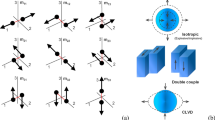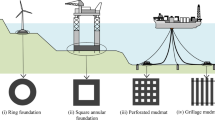Abstract
Tensile dynamic fractures were propagated under two experimental congifurations for the purpose of assessing the relative amount of strain energy release that is consumed as fracture energy and radiated as seismic waves. The configurations used were (1) application of localized thermal stresses to 2.29 mm-thick plates of soda-lime glass and (2) double cantilever beam (DCB) experiments in 12.7 mm-thick glass plates, in which a fracture is propagated from a notch at one end of the specimen by application of a transverse load. Fracture propagation velocities of 0.35–2 mm/μs were obtained for fractures in the first configuration. A capacitance transducer with a point-like probe was used for measuring the seismic displacement waveforms from propagating fracture sources. This transducer is capable of measuring absolute surface displacements with a resolution of 0.01 nm. It has a flat frequency response in the range 10 kHz to 6 MHz. Measured seismic efficiencies, or the ratio of radiated seismic energy to strain energy released, are in the range 10−5 to 10−3.
Similar content being viewed by others
References
Aki, K. andRichards, P. G.,Quantitative Seismology, Theory and Methods, (W. H. Freeman and Co., San Francisco 1980).
Båth, M. (1967),Earthquake energy and magnitude. Physics and Chemistry of the Earth7, 115–165.
Boatwright, J. (1980),A spectral theory for circular seismic sources; simple estimates of source dimensions, dynamic stress drops, and radiated seismic energy. Bull. Seismol. Soc. Am.70, 1–21.
Boler, F. M.,Brittle Dynamic Fracture Experiments: A Comparison of Radiated Seismic Energy and Fracture Energy (University of Colorado Ph.D. Thesis, Boulder 1985).
Boler, F. M., andSpetzler, H. A. (1984),Seismic radiation in controlled dynamic fracture experiments. EOS (abs)65, 1074.
Boler, F. M., H. A. Spetzler, andC. C. Getting (1984),A capacitance transducer with a point-like probe for receiving acoustica emissions. Rev. Sci. Instrum.55, 1293–1297.
Bullen, K. E.,An Introduction to the Theory of Seismology,3rd Ed., (Cambridge University Press, Cambridge 1963).
Burns, S. J. andWebb, W. W. (1966),Plastic deformation during cleavage of LiF, Trans. Metal. Soc. AIME236, 1165–1174.
Corning Glass Works,Properties of Selected Commercial Glasses, (Corning Glass Works, Corning, New York, 1971).
Ewing, M., Jardetzky, W. andPress, F. Elastic Waves in Layered Media, (McGraw-Hill, New York 1957).
Gilman, J. J.,Cleavage, Ductility and Tenacity in Crystals, inFracture, edited by Averbach et al., (J. Wiley and Sons, New York 1959), 193–224.
Hahn, G. T., Hoagland, R. G., Rosenfeld, A. R. andSejnoha, R. (1974),Rapid crack propagation in a high-strength steel, Metallurg. Trans.5, 475–482.
Haskell, N. A. (1964),Total energy and energy spectral density of elastic wave radiation from propagating faults. Bull. Seismol. Soc. Am.54, 1811–1841.
Hoagland, R. G. (1967),On the use of the double cantilever beam specimen for determining the plane strain fracture toughness of metals. J. Basic Engin. September, 525–532.
Husseini, M. I. andRandall, M. J. (1976),Rupture velocity and radiation efficiency. Bull. Seismol. Soc. Am.66, 1173–1187.
Inglis, C. E. (1913),Stresses in a plate due to the presence of cracks and sharp corners. Trans. Roy. Inst. Naval Archit.55, 220–241.
Irwin, G. R. (1957),Analysis of stresses and strains near the ends of a crack traversing a plate. J. Appl Mech.24, 361–364.
Kanninen, M. F. (1973),An augmented DCB model for crack propagation and arrest. Int. J. Fract.9, 83–92.
Lawn, B. R. andWilshaw, T. R.,Fracture of Brittle Solids, (Cambridge Univ. Press, Cambridge 1975).
Savage, J. C. (1965),The effect of rupture velocity on seismic first motions. Bull. Seismol. Soc. Am.55, 263–275.
Savage, J. C. andHasegawa, H. S. (1964),Some properties of tensile fractures inferred from elastic wave radiation. J. Geophys. Res.69, 2091–2100.
Savage, J. C. andHasegawa, H. S. (1965),A two dimensional model study of the directivity function. Bull. Seismol. Soc. Am.55, 27–45.
Savage, J. C. andMansinha, L. (1963),Radiation from a tensile fracture, J. Geophys. Res.68, 6345–6358.
Schmuely, S. andPeretz, D. (1976),Static and dynamic analyses of the DCB problem in fracture mechanics. Int. J. Sol. Struct.12, 67–79.
Swanson, P.,Subcritical Fracture Propagation in Rock: an Examination Using the Methods of Fracture Mechanics and Non-Destructive Testing (University of Colorado Ph.D. Thesis, Boulder 1984).
Wiederhorn, S. M. (1969),The fracture surface energy of glass. J. Am. Ceram. Soc.52, 613–646.
Author information
Authors and Affiliations
Rights and permissions
About this article
Cite this article
Boler, F.M., Spetzler, H. Radiated seismic energy and strain energy release in laboratory dynamic tensile fracture. PAGEOPH 124, 759–772 (1986). https://doi.org/10.1007/BF00879609
Received:
Accepted:
Issue Date:
DOI: https://doi.org/10.1007/BF00879609




